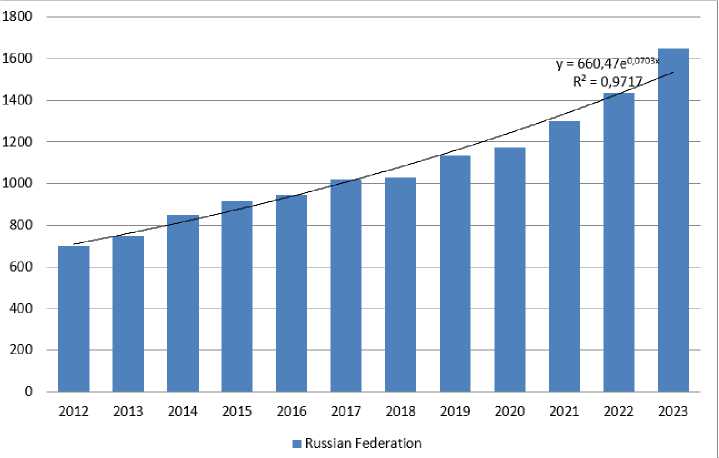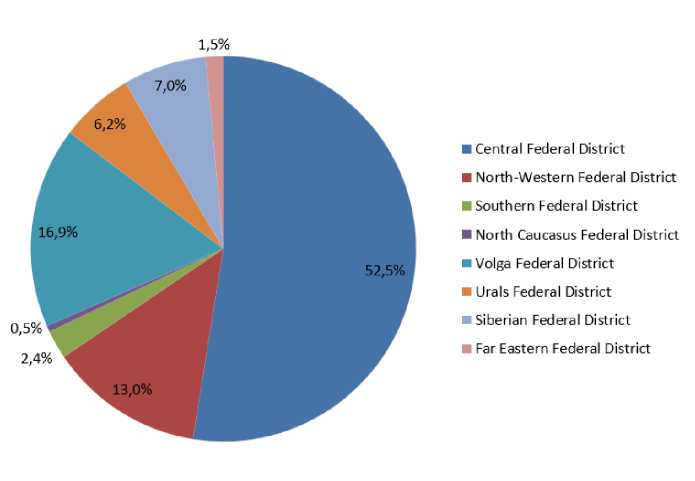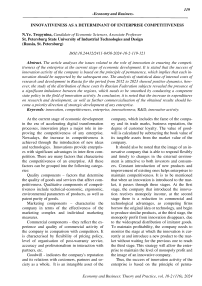Innovativeness as a determinant of enterprise competitiveness
Автор: Tropynina N.Ye.
Журнал: Экономика и бизнес: теория и практика @economyandbusiness
Статья в выпуске: 10-2 (116), 2024 года.
Бесплатный доступ
The article analyses the issues related to the role of innovation in ensuring the competitiveness of the enterprise at the current stage of economic development. It is stated that the success of innovation activity of the company is based on the principle of permanence, which implies that each innovation should be supported by the subsequent one. The analysis of statistical data of internal costs of research and development in Russia for the period from 2012 to 2023 showed positive dynamics, however, the study of the distribution of these costs by Russian Federation subjects revealed the presence of a significant imbalance between the regions, which needs to be smoothed by conducting a competent state policy in the field of innovation activity. In conclusion, it is noted that the increase in expenditures on research and development, as well as further commercialisation of the obtained results should become a priority direction of strategic development of any enterprise.
Innovation, competitiveness, enterprise, innovativeness, r&d, innovative activity
Короткий адрес: https://sciup.org/170206706
IDR: 170206706 | DOI: 10.24412/2411-0450-2024-10-2-119-121
Текст научной статьи Innovativeness as a determinant of enterprise competitiveness
At the current stage of economic development in the era of accelerating digital transformation processes, innovation plays a major role in improving the competitiveness of any enterprise. Nowadays, the increase in competitiveness is achieved through the introduction of new ideas and technologies. Innovations provide enterprises with significant advantages in inter-firm competition. There are many factors that characterise the competitiveness of an enterprise. All these factors can be grouped into the following categories:
Quality components – factors that determine the quality of goods and services that affect competitiveness. Qualitative components of competitiveness include technical-economic, ergonomic, environmental parameters of products, as well as patent purity of goods.
Marketing components – characterize the company in terms of the effectiveness of the marketing complex and individual marketing measures.
Commercial components – they reflect the experience and quality of commercial activity of the company in comparison with competitors. It is characterised by flexibility of pricing policy, level of organisation of post-warranty service, accuracy and professionalism in interaction with partners, etc.
Goodwill - indicates the company's reputation and its relations with customers, partners and society as a whole. It is an intangible asset of the company, which includes the fame of the company and its trade marks, business reputation, the degree of customer loyalty. The value of goodwill is calculated by subtracting the book value of its tangible assets from the market value of the company.
It should also be noted that the image of an innovative company that is able to respond flexibly and timely to changes in the external environment is attractive to both investors and consumers. Constant introduction of new products and improvement of existing ones helps enterprises to maintain competitiveness. It is to be mentioned that when an innovation is introduced to the market, it passes through three stages. At the first stage, the company that introduced the innovation receives monopoly income, at the second stage there is a reduction in commercial and technological advantages, as competing firms borrow the original idea or technology, and begin to produce similar products, at the third stage, the monopoly profit from innovation disappears, due to the widespread distribution of imitator goods. To maintain profitability, the company needs to monitor the stage at which the innovation is currently at and introduce a new product to the market without waiting for the previous one to reach the third stage. This strategy will allow the enterprise to maintain the level of monopoly profit and the image of an innovative company.
Thus, the success of innovation activity of the enterprise is based on the principle of perma- nence, which implies that each innovation should be supported by the subsequent one. This principle allows avoiding the loss of monopoly profits, as constant updates make it difficult for competitors to copy products or technologies. The policy of regular innovations is one of the most important factors in the development of the activity of any modern organization, it requires it to make substantial expenditures on research and development.

Fig. 1. Domestic expenditures on research and development in the Russian Federation for the period 2012-2023 (billion rubles) [1]
In comparison, in China this indicator in 2023 is 2.6%, in the USA and Israel in 2021 – 3.5% and 5.6% [2].

sary to pay attention to the existing disproportion and take measures to equalise and stimulate innovation activity in all Russian regions in order to achieve harmonious development and effective functioning of the Russian economy.
Список литературы Innovativeness as a determinant of enterprise competitiveness
- Official website of the Federal State Statistics Service. - [Electronic resource]. - URL: http://www.gks.ru.
- Kulagin, V. China spent more than $458bn on R&D in 2023 // V. Kulagin, G. Mishutin // Vedomost. - [Electronic resource]. - URL: https://www.vedomosti.ru/politics/articles/2024/03/06/1023890-kitai-potratil-na-niokr-bolee-458-mlrd.
- Statistical Portal. - [Electronic resource]. - URL: https://www.statista.com.


